I doubt there is any artwork that costs more than $200 to build in the large “Greater New York” exhibition at MoMA PS1. By contrast, the average piece displayed at Art Southampton, for example, would cost $2,500 to create and frame.
In turn, this is still small change compared to the gloss at the Art Basel-Miami fair every December, where $50,000 castings are routine. And even that doesn’t approach the production costs for the $1 million castings of a Jeff Koons recently at the Whitney, or Anish Kapoor at Versailles.
In “Greater New York,” the fourth quinquennial at PS1, MoMA’s Long Island City think tank, the four curators of the exhibition took the term “greater” to mean time as much as geography, thereby breaking from the previous shows, which emphasized youth. The result is a compelling mix of 400 works by 158 artists, heavy on art from the 1970s and early ’80s exhibited with some newer artists not yet known.
And all of it made out of nothing.
This exhibition was co-organized by Peter Eleey, Curator and Associate Director of Exhibitions and Programs, MoMA PS1; art historian Douglas Crimp, University of Rochester; Thomas J. Lax, Associate Curator, Department of Media and Performance Art, MoMA; and Mia Locks, Assistant Curator, MoMA PS1.
The beginning date for the works on view is around 1976, the year the former PS 1 (Public School #1) was retasked to exhibit contemporary art. This goes back to a time before the odd marriage of art and money, when making art was a poetic activity cloistered on the margins between showing up for day jobs. It was a small town then, as Tom Wolfe was fond of noting in his 1975 art world sendup, “The Painted Word,” and he accurately numbered the clan somewhere around 8,000 people.
Currently one could find 8,000 people in a single tent among dozens at a major art fair, and the industry itself–yes it is now an industry–has the financial activity of a medium sized country.
There are those who wish it was otherwise, and among them are the curators of this curious and engaging show of art made on the cheap. Kinkos color copies seem to work just fine for many pieces and newsprint for others. In the press release that accompanies the show, and everywhere else, there is talk of a crisis of real estate movers and shakers ejecting artists from one neighborhood after another, and finally out of New York City. This diaspora, mixed with the mobile art fairs that pop up by the hundredfold each year, has left the art world without a center–physically or emotionally.
Hence this unusual show of art centered in New York City from when it was the center and very heart of the art world. There is little dead air here, no market-darling abstraction, and no point scanning an ArtNet app for market valuation because mostly there is none. Instead here is the plaintive soul articulating an emotive swirl into physical form.
A fun work by photographer Rosalind Fox Solomon (b. 1930) sets the tone for “greater” in the sense of time in this show rather than a geographical delineation. Born a decade before WWII and still working, she exhibits everyone’s favorite piece, “Cutouts” from 1986, wherein President Reagan stands with the fictional Sonny Crockett and Ricardo Tubbs from the series “Miami Vice” and the fictional Thomas Magnum from “Magnum P.I.” with Alexis Carrington Colby of “Dynasty” standing off to the side. Since Reagan had once been an actor, from this gathering of characters it seems reasonable to assume that the artist is suggesting that while he was in office, he was playing a fictional president.
.
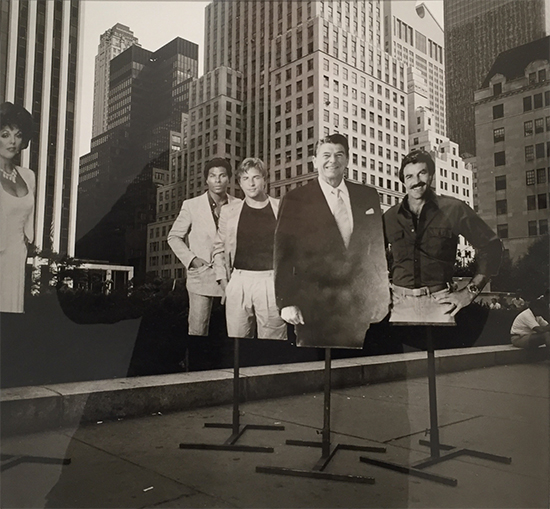
"Cutouts" by Rosalind Fox Solomon, 1986.
.
There are many pieces in the show dealing with the subject of the AIDS epidemic, which hit the art world very hard in the ’80s. One to linger on was a stack of newspapers by “fierce pussy” a “collective of queer women artists” entitled “For The Record”: this piece wonders about how someone’s life might be today if their light had not been extinguished by the killer virus. “If she were alive today maybe she’d have a gallery by now,” and other poignant ruminations. The fierce pussy collective is known for text art posters plastered around the city and their works do not often appear in shows; “For the Record” is a welcome and jarring addition to this one.
.
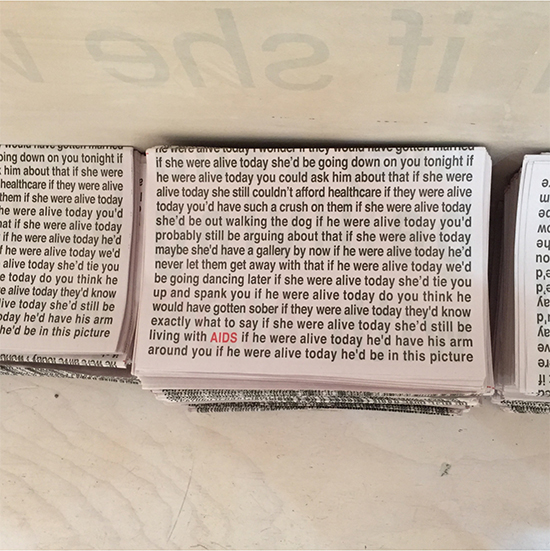
"For the Record" by fierce pussy, 2010-2015.
.
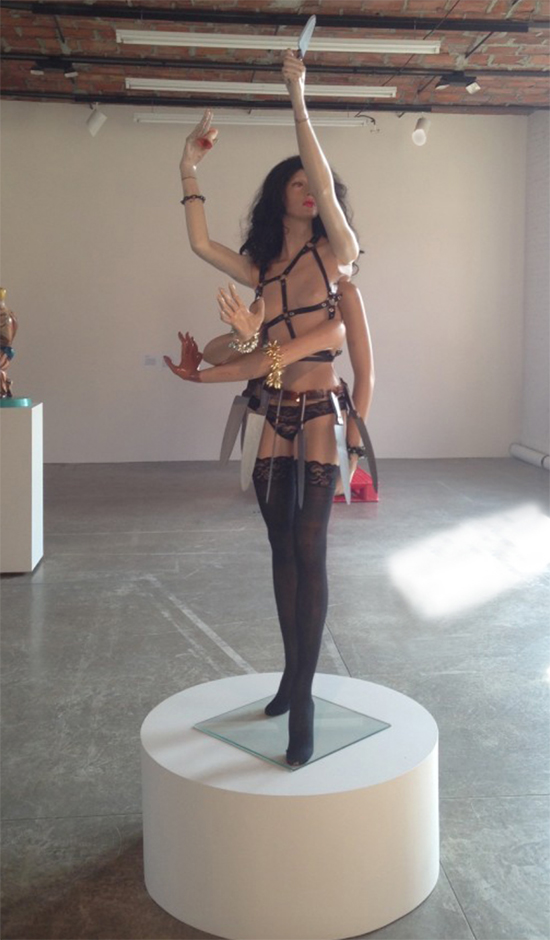
"Kali Bobbit" by Mary Beth Edelson, 1994. Mannequin and mixed media.
.
The altered mannequin “Kali Bobbit” by Mary Beth Edelson (b. 1933) was another popular piece in the show. Altering mannequins seems more like a West Coast phenomenon typical of Ed Kienholz and other California artists; that practice and taxidermy were common as the art world transitioned from abstraction borne of generations of modernism to figuration. This followed the enthusiasm of the 1970s, but because of the lack of figurative skills it was common to use existing figuration, e.g. mannequins, and alter them.
Ms. Edelson’s piece is apparently about domestic violence and she draws from Kali, the multi-armed Hindu Goddess of empowerment, whose task was to destroy evil forces. The execution of the piece is clumsy but the idea is sound.
David Hammons (b. 1943) was appalled upon arriving in New York to see how different the local artists were from those he knew in California. In his home state, art is more like an intellectual club with round table discussions of theory and direction, but it was all about business in New York City. His response to this new situation made him into an instant legend when he sold snowballs on a Brooklyn street after a blizzard; his Duchampian act was a laugh out loud commentary on the NYC status quo as he found it.
In “Greater New York,” Hammons shows his “African American Flag” to continued humorous effect and a sendup of the powers that be.
.
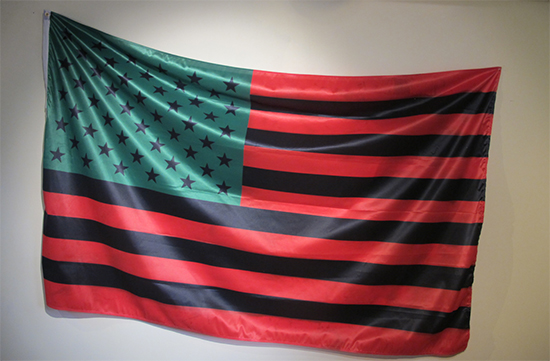
David Hammons, "African American Flag" by David Hammons, date unknown.
.
Red Grooms (b. 1937) has been for decades a staple of New York City. Originally a student of abstraction guru Hans Hoffman, he gravitated toward Pop art and cartoons, with the mayhem of New York as his subject. He has worked in different mediums and often at the same time. Here he shows his “Mr. Universe” from 1990, a musclebound humor filled statue of bodybuilding culture.
.
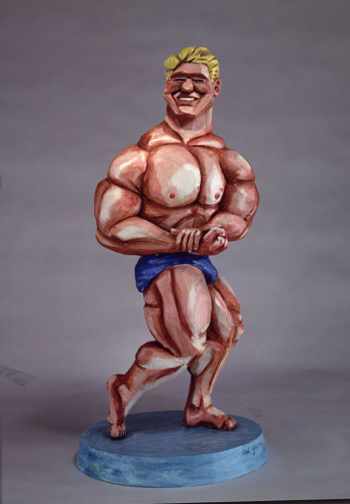
"Mr. Universe" by Red Grooms. © Red Grooms / Artists Rights Society (ARS), New York.
.
The show is a must-see event that gives a time slice of New York as it was decades ago. Much has changed since then and this is a source of worry for old timers that it will never be as good as it was. Such is the nature of change, which is perhaps the only constant.
_____________________________
BASIC FACTS: "Greater New York" remains on view through March 7, 2016. MoMA PS1 is located at 22-25 Jackson Ave., Long Island City, NY 11101. www.momaps1.org.
_______________________________
Copyright 2015 Hamptons Art Hub LLC. All rights reserved.
